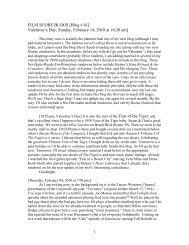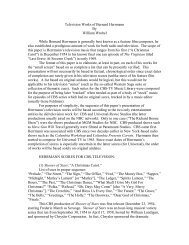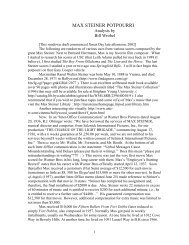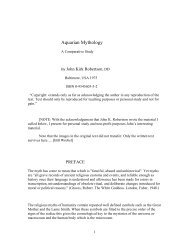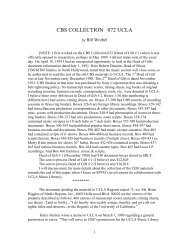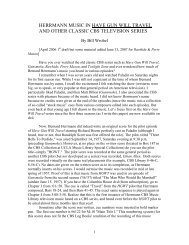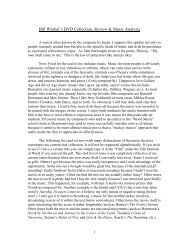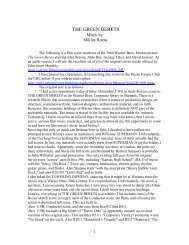FAHRENHEIT 451 - Film Score Rundowns
FAHRENHEIT 451 - Film Score Rundowns
FAHRENHEIT 451 - Film Score Rundowns
You also want an ePaper? Increase the reach of your titles
YUMPU automatically turns print PDFs into web optimized ePapers that Google loves.
he had to be the messenger between Truffaut and Herrmann. T. would tell Tom that he disliked the<br />
xylophones Herrmann employed, and that he was to go over to Herrmann and tell him that! So he does, and<br />
Herrmann gruffly says, "Go back and ask him why!" So Tom goes back to Truffaut, and T. says "Because it<br />
sounds comical. Tell him that." So Tom sheepishly goes back to Herrmann to tell him, and Herrmann<br />
states, "They didn't laugh at Ravel." So Tom tells Truffaut that, and T. says, "Tell Herrmann that he's not<br />
Ravel" (but smartly, Tom never relied that exact sentiment!). So it appears that Truffaut was being a bit of<br />
an ass there, hypercritical. Trauffaut also edited the music very heavily in the final print, and did it even far<br />
more drastically in his later collaboration with Herrmann on "The Bride Wore Black."<br />
Smith comes on to make a very good point about how the music in certain sequences was like nursery<br />
game music because after all these futuristic characters were rather two-dimensional and childlike in a<br />
repressed way.<br />
In the feature commentary, Smith comes on briefly in several locations. He first speaks in Chapter 5<br />
at about 4:20, and then in Chapter 8 at 3:25, the start of Chapter 12, Chapter 14 at 4:30 (book burning<br />
sequence) etc. A few of the others also discuss the music as well very briefly. Tom Noble talks about the<br />
music in Chapter 12 I believe, about how Herrmann was a crotchety person, and it was a stark contrast of<br />
how that man (outer difficult persona) could write such beautiful romantic music. Overall the multiple<br />
commentary contributors was okay, but I preferred the more interesting in-depth commentary track (of four<br />
people) in "Ghost & Mrs. Muir."<br />
The Making Of documentary is educational. It was Julie Christie signing on that really clinched the<br />
movie and got the financial backing it needed. However, Bradbury objected to having Julie playing both<br />
roles (middle-aged Linda, and Clarisse). Clarisse was supposed to be a 16 year old, innocent, and so forth.<br />
Also Taruffaut really wanted to film the movie in black and white, but Universal was adamant about having<br />
it in color. It would be odd to me to film it in B/W especially with the pivotal fire scenes. No red/blue<br />
flames, no red fire engine,etc.<br />
In my opinion, "Ghost & Mrs. Muir was a better film, but I liked the score to Fah <strong>451</strong> better. As a<br />
movie, Fah <strong>451</strong> had many admirable qualities, but it also had many flaws. I preferred the book over the<br />
radically changed movie script. As given in my Fah <strong>451</strong> cue rundown on <strong>Film</strong> <strong>Score</strong> <strong>Rundowns</strong>, I thought<br />
the ending chapter ("The Book People") was ridiculous (although the music is excellent). I commented on<br />
how I hope the book people don't suffer from Alzheimer's soon or choose Aristotle as an author (Greek<br />
writers back then had the habit of dragging one sentence into a whole, long paragraph)!<br />
At any rate, I would recommend buying this dvd.”<br />
[Written Sunday, November 9, 2003:]<br />
I will expand a bit on the “missing” cues or cue fragments I had already discussed<br />
below (written over two years ago). Herrmann apparently made scissors-work on several<br />
cues, probably for his Phase Four re-recordings several years after the original release of<br />
the motion picture. Bars 16-22 of “Fire Alarm” I believe is from Bars 9-15 of “Fire<br />
Station” (when the xylophone makes its familiar appearance). This page )or rather half<br />
of the original page) has that xylophone written in but that xylophone line is not played in<br />
the “Fire Alarm” cue later on. The page is physically and radically scissored up. This<br />
perhaps means that this page section was used here in the latter cue (“Fire Alarm”) but<br />
the other half of that page from “Fire Station” was not.<br />
Another example is the “Bedtime” cue VII (end of Chapter 3 on the new dvd).<br />
Only about the first six bars were used (of the 12 bars in the first Moderato section).<br />
Then at :28 ½, we come to the Allegro Con Brio “Fire Station” music again (this time<br />
with the marimba, not the xylophone). But once again that section of the bottom of the<br />
page was put to the scissors (page 14) abd then page 15 is missing, and then the<br />
concluding bars of that Fire Station music (half of the top of page 16) was also cut out,<br />
coming to the :58 ½ point in the new or next Lento section. Of course in the movie/dvd,<br />
3




